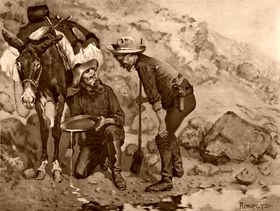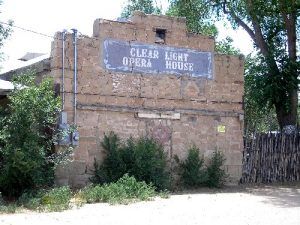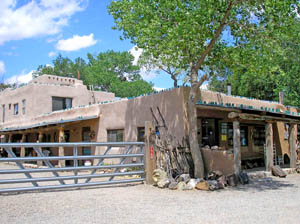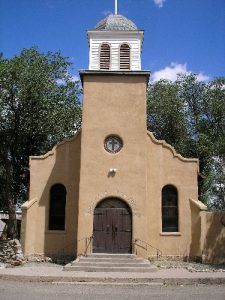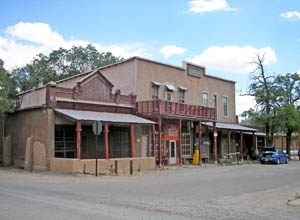
The old Simoni Store and Wortley Hotel on Front Street in Los Cerrillos, New Mexico by Kathy Alexander.
“From a historical standpoint, no section in the United States is possessed of so much interest.” — Fayette Jones, Director of the New Mexico Bureau of Mines, said of the Cerrillos Mining District in 1905.
Though the tiny town of Los Cerrillos wasn’t founded until 1879, the area’s history dates back more than 1,500 years to a time when turquoise and lead deposits played an important role in the lives of the first Native American inhabitants and influenced early Spanish explorations and the settlement of New Mexico.
The first Spanish explorers, disdaining turquoise and more interested in finding gold and silver, pretty much left these early Indians alone when they first came to the area in 1540. It wasn’t until the mid-1600’s that the area was settled by “outsiders” when a cattle ranch was established south of the Santa Fe River near Alamo Creek. At this time, the nearby hills were given the name Los Cerrillos, meaning “little hills.” Around this same time, the Spaniards returned and forced the Indians to work the Mina del Tiro Mine for silver until the Pueblo Revolt of 1680.
In 1695 Governor Vargas appointed a mayor for El Real de los Cerrillos, making it the oldest western mining settlement for a clear record. However, during the Reconquista of 1696, El Real de los Cerrillos was abandoned. Though most of the Spaniards were gone, the area Indians continued to make use of the mines.
In 1879, two miners from Leadville, Colorado, found deposits of gold in the area, and in no time, American prospectors rediscovered the ancient diggings in the Cerrillos Hills. Before long, hundreds of prospectors roamed the area in search of gold, silver, lead, copper, and turquoise. The Cerrillos Mining District was formed in March 1879, and almost immediately, over 1,000 claims were filed. Several mining camps sprang up, including Dimmick’s Camp, later known as Carbonateville, for its lode of silver carbonate.
The village of Los Cerrillos was first established as a tent camp between the lead and silver mines of the Carbonateville to the north and the coal mining camp of Madrid and the gold mines of the Placer and Ortiz Mountains to the south.
Los Cerrillos flourished as a natural access point between the two areas; however, it really began to grow with the railroad’s arrival in 1880. The town was laid out by the Santa Fe Railroad in 1880, and the same year, a post office was established. Two years later, the mining camp became an official city when the railroad siding was built, the town held its first election, and the first permanent home was completed.
The Cerrillos Hills’ mineral boom peaked in the mid-1880s when miners were extracting gold, silver, lead, zinc, and turquoise from their crusty depths. Some 3,000 prospectors were working the area hills and in the leisure time supported some 21 saloons, five brothels, four hotels, and several newspapers in the city. The town became so well known that it was seriously considered the capital of New Mexico. After Cerrillos’ peak mineral production in the 1880’s coal mining began to take over as the mainstay of the economy in the area.
In 1899, it was reported New Mexico’s production of turquoise was valued at $1,600,000, most of it coming from the Cerrillos Hills.
Just a few of the area mines survived into the 20th century, the biggest of which was the American Turquoise Company, a subsidiary of Tiffany’s of New York on the Cerrillos’ north side. When World War I commenced, several lead mining operations were reopened, including the Cash Entry and the Tom Paine mines. However, by the time the depression began in 1929, all large company mining was ceased. Today, some small private mines continue to be worked by hobbyists, but most turquoise mined in New Mexico still comes from these beautiful hills.
Today, the charming, tree-shaded town of Los Cerrillos is officially a “ghost town,” though many residents continue to live there and the town thrives as a Santa Fe day trip destination. On some days, these dusty streets are filled with traffic much like they were more than a century ago. The washboard dirt roads of Los Cerrillos and the remaining buildings on its old Front Street look much like a movie set, and in fact, have been used as in some 13 movies. The films The Nine Lives of Elfego Baca, Young Guns, Young Guns II, and Vampires were made there, as well as John Wayne’s 1972 movie, The Cowboys, filmed just north of the town.
This historic city still provides a few open businesses, including the Casa Grande Trading Post and Mining Museum, which also features a petting zoo. Here, you can purchase Cerrillos turquoise that is still mined and made by the Brown family at their family-owned Little Chalchihuitl Mine in the Cerrillos Mining District. The town also sports the What Not Shop filled with antiques of every description, an old saloon, an art gallery, and riding stables. The Saint Joseph Church, built in 1922, still holds mass every Sunday, and the village water still flows from the original dam that the Santa Fe Railroad built.
While in Cerrillos, an absolute “must stop” is the Cerrillos Hills Historic Park, just north of town. Here, along the hiking and biking trails, evidence of the old mines that dot the area, the low stone walls and ruins of Carbonateville, and prehistoric stone rings and petroglyphs from its ancient Indian days.
The Cerrillos Mining District is listed on the New Mexico State Register of Cultural Properties. Also, it is included in the US Department of Interior’s National Survey of Historic Sites and Buildings.
Los Cerrillos is about three miles north of Madrid, New Mexico, along the Turquoise Trail Scenic Byway (NM 14).
©Kathy Weiser/Legends of America, updated November 2024.
Also See:
The Turquoise Trail Scenic Byway
Golden, New Mexico Has Seen Better Days
Madrid, New Mexico – A Ghost Town Reborn
New Mexico – Land of Enchantment
Take nothing but photos – leave nothing but footprints – break nothing but silence – kill nothing but time.
—Explorer’s Code

